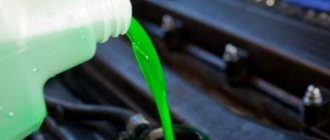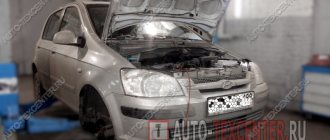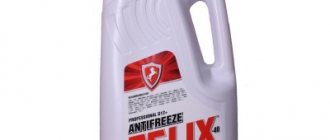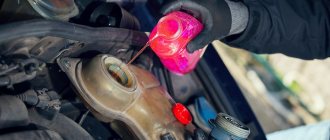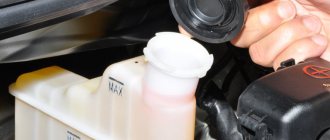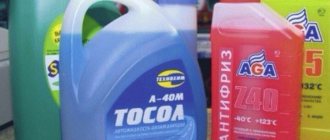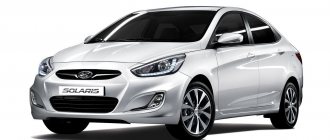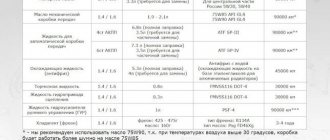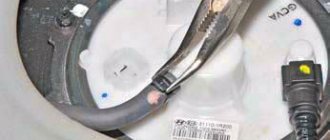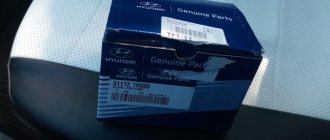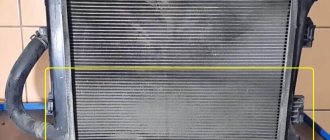2272-4-9-05
Pour coolant through the filler neck until the liquid flows into the expansion tank.
Pour liquid into the expansion tank 3–4 cm above the L mark. Close the expansion tank lid.
We start the engine, stop it after two minutes of operation and add liquid to the filler neck of the cooling system. Close the filler cap of the cooling system and warm up the engine. We stop the engine and after it has cooled down, check the coolant level and bring it to normal.
[We save up to 5,000 rubles on Hyundai Solaris maintenance] [Hyundai Solaris maintenance for 15 thousand kilometers] [Hyundai Solaris maintenance for 45 thousand kilometers] [Hyundai Solaris maintenance for 60 thousand kilometers] [Do it yourself Maintenance - general recommendations] [Safety rules for carrying out vehicle maintenance yourself] [ Tools required for maintenance of Hyundai Solaris]
Hyundai Solaris coolant replacement
Replacement frequency, what antifreeze to fill
According to the manufacturer’s regulations, the first replacement for a Hyundai Solaris should be made after a mileage of no more than 200 thousand kilometers. And with low mileage, the service life is 10 years. Further replacements depend on the fluid used.
According to the recommendation of the automobile concern, you need to use original Hyundai Long Life Coolant antifreeze to fill the cooling system. It comes as a concentrate that must be diluted with distilled water.
The original liquid comes in several forms, in a gray or silver canister with a green label. It must be changed every 2 years. At one time it was the only one recommended for replacement. Since then, information has been floating around the Internet, which is what needs to be used. But at the moment it is not advisable to use it, since it is created on an outdated silicate base. But just in case, here are the order codes 07100-00200 (2 l.), 07100-00400 (4 l.)
Now for replacement you should choose antifreeze in a green canister with a yellow label, which is designed for 10 years of operation. At the moment, this will be the best option, as it fully meets modern requirements. Complies with Hyundai/Kia MS 591-08 specification and belongs to lobride fluids and the phosphate-carboxylate (P-OAT) class. You can order using these articles 07100-00220 (2 l.), 07100-00420 (4 l.).
How much antifreeze is in the cooling system, volume table
| Model | Engine capacity | How many liters of antifreeze are in the system | Original liquid / analogues |
| Hyundai Solaris | gasoline 1.6 | 5.3 | Hyundai Long Life Coolant |
| gasoline 1.4 | Crown LLC A-110 | ||
| CoolStream A-110 | |||
| RAVENOL HJC Hybrid Japanese Coolant |
Replacement process
There are several generations of Hyundai Solaris cars. They do not have fundamental differences in the cooling system, so the instructions for replacing antifreeze given below will apply to all models.
To replace the coolant you will need:
- High-quality and suitable antifreeze (5.3 l)
- Clean rags
- A container (bucket, canister, basin) with a volume of at least 7 liters for draining the waste
The general rule when replacing antifreeze is to carry out all procedures on a flat, horizontal platform and after the engine has cooled.
The procedure is as follows.
Unscrew the expansion tank cap and the radiator filler plug to release excess pressure. Remove the left mudguard of the engine compartment - it is located under the engine block.
Place a container under the drain valve located in the lower left corner of the radiator.
Unscrew the tap 2-3 turns and drain the old antifreeze.
If the O-ring is damaged, replace it. Select the part according to the catalog number.
After completely removing the old fluid from the radiator, tighten the drain valve. Slide the clamp located on the lower radiator hose by squeezing it with pliers.
Remove the hose from the radiator tank socket and drain the antifreeze from the engine into a nearby container. Reinstall the lower radiator hose.
Remove any remaining antifreeze from the expansion tank - this can be conveniently done using a medical bulb.
Fill the cooling system with fresh coolant through the radiator neck until it begins to overflow. Screw the filler cap tightly.
Fill the expansion tank with antifreeze to about. Start the engine and warm it up to operating temperature (until the fan starts). Stop the engine and check the coolant level. If necessary, add it to about.
Antifreeze Hyundai Solaris 1.4 - 1.6 from 2011 to 2022
Factory recommendation: First replacement 210 thousand km or 120 months. Then every 30 thousand km or 24 months.
Our recommendation is slightly different: If you plan to drive after 200 thousand km and, if possible, avoid problems with the pump, then it is advisable to replace the fluid earlier. . Why? Let's figure it out.
- In the manual, the resource is considered in time and mileage. If there are no questions by time, then the mileage figure needs clarification. When the car is mainly driven on the highway, without being in city traffic jams, you can focus on mileage, but usually the opposite is true. In this case, the engine operating time - engine hours - increases significantly and by 200 thousand km the antifreeze already loses a significant part of its properties. It is necessary to take into account that in traffic jams the coolant temperature is higher than on the highway. The difference is almost 10 degrees. You can notice how often the radiator cooling fan comes on during hot weather. Sometimes it works almost non-stop. All this negatively affects the life of the liquid.
- As for the entry in the manual: Then every 30,000 km or 24 months. The entry is strange and only valid if the cheapest coolants are used. If you use high-quality products, such a recommendation will not be correct. The timing and periods of replacement can be significantly extended.
- Another point that is also important is the cleanliness of the radiators. This does not mean inside, but outside - the radiator honeycombs themselves. We have two radiators in front. First the air conditioner radiator, then the main one. If they are clogged, this also affects the operating temperature of the fluid, and therefore its service life.
The bottom of the radiator is clogged with dirt
- Check whether you have radiator protection and in what condition it is. Small plastic part under the bumper.
Without it, radiators clog much faster.
How do you know if the fluid needs to be replaced or not?
If you bought a used car, you shouldn't look at the mileage. In Solaris it is very easy to twist. You can find out that it is twisted only by indirect signs. Mileage data is stored in only one chip, into which the new mileage is recorded. The second reason why you should not rely on odometer readings is the possible replacement of the radiator. If the radiator was changed (let's say the car got into an accident or a dog was hit, which happens quite often), then we can assume that the cheapest antifreeze was poured in. For some reason, many people think that they can fill in any color as long as they want it. As a rule, they take the cheapest one.
Recommendation: If the antifreeze does not have a clear factory color, REPLACE IT WITH A NEW one - one that you will be absolutely sure of! If you have a car with a transparent history, use the recommendations above.
Where to see the fluid level and color
If the car is cold and you just want to see the color of the fluid, it is more convenient to do it here.
On a warm car, the fluid level can be viewed here.
Over time, the tank becomes cloudy, and it becomes difficult to see the level and, even more so, understand the color of antifreeze. In this case, even with a warm car, you can remove the cap from the reservoir and determine the fluid level using the hose. If you look into the tank, you can see the color.
How to check the quality of new antifreeze?
Unfortunately, the situation on the market today is such that when buying even a well-known brand, it is advisable to check the quality of the purchase. Fortunately, this is very easy to do - just heat the liquid to a boil and see at what temperature it boils. It has been noticed that all the raw materials boil very early, but the high-quality ones do not boil before 107 degrees C at atmospheric pressure.
Tips for replacing coolant
When replacing the coolant, do not open the radiator cap while the engine is running or hot. This can cause burns due to the release of hot liquid or steam, and can also cause failure of the engine cooling system.
Wait until the engine has cooled before replacing. Unscrew the radiator cap with the utmost care by wrapping the cap in a thick cloth and slowly twisting it counterclockwise .
Inspect the technical condition of all cooling and heating pipes and their connections. If there are worn parts, replace them.
The antifreeze level in the coolant tank must be located between the marks F (full) and L (low), marked on the edge of the expansion tank of the engine cooling system.
If the level is insufficient, it is necessary to top up the coolant to about. This will protect the cooling system from corrosion and freezing.
If you frequently add antifreeze to the system, it is recommended to check the system at a Hyundai service station for leaks.
Accidentally pouring antifreeze into the windshield washer reservoir can cause poor visibility when sprayed onto the windshield and/or damage the paintwork.
Necessary tools and materials for replacing antifreeze
List of what is needed for work:
- new coolant;
- clean rags;
- pliers;
- container for draining old fluid of at least 7 liters.
How do you know if the fluid needs to be replaced or not?
If you bought a used car, you shouldn't look at the mileage. In Solaris it is very easy to twist. You can find out that it is twisted only by indirect signs. Mileage data is stored in only one chip, into which the new mileage is recorded.
The second reason why you should not rely on odometer readings is the possible replacement of the radiator. If the radiator was changed (let's say the car got into an accident or a dog was hit, which happens quite often), then we can assume that the cheapest antifreeze was poured in. For some reason, many people think that they can fill in any color as long as they want it. As a rule, they take the cheapest one.
Recommendation: If the antifreeze does not have a clear factory color, REPLACE IT WITH A NEW one - one that you will be absolutely sure of! If you have a car with a transparent history, use the recommendations above.
Articles and numbers of antifreeze
0710000400 - original Korean Hyundai/Kia antifreeze in a 4l canister. 0710000200 - the same antifreeze, but in a 2 liter canister.
R9000AC001K and R9000AC001H are original antifreezes used in Russia. The last letter of the number means the difference in the antifreeze packaging: K - Kia, N - Hyundai. Canister volume 1 l.
How to check the quality of new antifreeze?
Unfortunately, the situation on the market today is such that when buying even a well-known brand, it is advisable to check the quality of the purchase. Fortunately, this is very easy to do - just heat the liquid to a boil and see at what temperature it boils. It has been noticed that all the raw materials boil very early, but the high-quality ones do not boil before 107 degrees C at atmospheric pressure.
The temperature can be measured using, for example, a multimeter or an infrared thermometer
An infrared thermometer can give an error in the range from 3 to 7 degrees. This needs to be kept in mind.
Only 95, sometimes even below 90
If you do not check the liquid by temperature, check it visually by color. Counterfeit goods, as a rule, always very quickly lose their original color and become colorless or brown.
Reason to think about replacing
If you are unlucky with antifreeze or you have already bought a car with such liquid, the system needs to be flushed. How to do this is written below.
The most popular engine for Hyundai Solaris
Gamma engines divide this line almost in half, but still, the G4FC engine “withstood” a little more configurations. They are very similar to each other. The FC engine was “increased” in displacement from 1396 to 1591 cubic centimeters, increasing the free stroke of the piston. The year of birth of the unit is 2007. The assembly place is the Hyundai automobile plant in the capital of China, Beijing.
Inline four-cylinder fuel-injected engine producing 123 hp. designed to meet Euro 4 and 5 environmental standards. Fuel consumption (for the option with a manual transmission):
- in the city - 8.0 l.;
- outside the city - 5.4 liters;
- combined - 6.4 l.
The motor has a number of design features characteristic of modern Korean engines:
- distributed injection of the MPI type (multipoint multi point injection);
- the cylinder block and head are made of light and durable aluminum alloy;
- plastic intake manifold;
- two camshafts (DOHC);
- chain drive with tensioner in the timing mechanism.
Of particular interest is the multipoint distributed injection system installed in the engine. It has five main structural elements:
- Throttle valve.
- Ramp (main) for fuel distribution.
- Injectors (nozzles).
- Air consumption (or pressure/temperature) sensor.
- Fuel regulator.
The operating principle of the system is quite simple. The air passes through the atmospheric filter, mass flow sensor and throttle valve into the intake manifold and engine cylinder passages. Fuel comes to the injectors through a ramp. The proximity of the intake manifold and injectors minimizes gasoline losses.
More on the topic: Hyundai Solaris tires: standard and permissible tire sizes, pressure
Control is carried out using the computer. The computer calculates the mass fractions and quality of the fuel mixture based on load, temperature, engine operating conditions and vehicle speed. The result is electromagnetic pulses for opening and closing the injectors, supplied at a certain moment from the control unit.
MPI injection can operate in three modes:
- simultaneously;
- in pairs;
- individually.
The advantages of this fuel injection scheme include efficiency and full compliance with environmental standards. But those who prefer to buy a car with an MPI engine should forget about dashing high-speed driving. Such engines are much more modest in terms of power than those in which the operation of the fuel system is organized according to the principle of direct supply.
For the G4FC, Hyundai has set a fairly low mileage threshold - 180 thousand km (10 years of operational use). In real conditions, this figure is much higher. Various sources provide information that Hyundai Solaris taxis cover up to 700 thousand km. mileage A relative disadvantage of this engine is the lack of hydraulic compensators as part of the timing mechanism, and the need to adjust the valve clearances.
Overall, the G4FC proved to be an excellent motor: light in weight, inexpensive to maintain and unpretentious. However, it is worth considering that from the point of view of major repairs, this is a one-time item. All that can be done on it is plasma spraying of cylinders and boring to the nominal size. However, is it necessary to think about what to do with an engine that can easily “travel” half a million kilometers is a rhetorical question.
More about Solaris
- General information about the Hyundai Solaris
- Solaris engine overhaul
- Weaknesses of Solaris. Main problems of Hyundai Solaris: Infographics.
- Hyundai Solaris Body Dimensions - Dimensions Tables
- How serious are the problems of the Hyundai Solaris?
- Tuning Hyundai Solaris with your own hands: interior, optics, chip tuning
- Hyundai Solaris 2022: Comfort package
- Hyundai Solaris 2022 - photos and prices, videos, characteristics of the new Hyundai Solaris 2
- We bring the updated Hyundai Solaris into the lair of competitors. Test drive hyundai solaris - DRIVE
- Hyundai Solaris 1.4, 1.6 fuel consumption per 100 km
What antifreeze is in the Solaris cooling system from the factory?
This antifreeze is poured into domestically assembled Solaris.
If you look through the manual, it will not give a specific answer on the brands of coolant. There they will write that the volume of the cooling system of both engines is 5.3 liters, and you need to pour a mixture of ethylene glycol concentrated antifreeze and distilled water in a one-to-one ratio.
- From the assembly line in Korea, Solaris is filled with Hyundai Long Life Coolant with Korean specification MS-591-08.
They pour such antifreeze on foreign Solaris, with funny hieroglyphs on the packaging
- Russian-assembled cars can be filled with CoolStream A-110 or Crown LLC A-110 antifreeze (catalog number R9000AC001K).
The back side shows the article number.
Both of these liquids are produced in the Russian Federation, so the price for them suits the manufacturer. Original Hyundai fluid is also on sale, but costs much more.
The plant strongly discourages the use of antifreeze of other brands, much less of lower quality, and in this it is absolutely right. That's why.
What antifreezes should not be poured?
All modern coolants are divided into several categories based on composition. In short, antifreeze not only does not freeze in the cold, but also has a number of important functions:
- it lubricates the pump;
- does not cause engine corrosion;
- does not boil at temperatures of 130-140 degrees;
- flushes the cooling system;
- does not form foam.
The liquid obtains these properties thanks to the main component and, of course, additives. So, based on the type of main component, antifreezes can be:
- Ancient antifreezes based on sodium nitrite, trisodium phosphate and other nitrites. They are painted blue; such liquids do not contain additional corrosion inhibitors that can resist the destruction of aluminum at high temperatures. The most famous unfortunate liquid from this company is the Soviet Antifreeze. Pouring such antediluvian antifreeze into a modern engine is a death sentence for the cylinder block, radiators and cylinder head. Such antifreezes have a particularly detrimental effect on diesel engines.
Regular Antifreeze is not recommended for use on Hyundai Solaris.
- Silicate-based antifreezes. Silicates are salts of silicic acid, roughly speaking, liquid glass. More modern fluids with a minimal set of additives, but they have a big drawback - over time, they leave a coating on the walls of the cooling system about half a millimeter thick, and this greatly impairs the heat transfer of the engine. In addition, during operation, quartz sediment and sand may fall out, but it will work as a good abrasive. Goodbye pump.
- The most modern antifreezes are carboxylate. Protection of aluminum and engine alloys from corrosion is achieved through organic acids. This antifreeze leaves virtually no traces behind, lasts longer than others, but also requires timely replacement, since as the fluid ages, its anti-corrosion properties sharply decrease.
According to the modern classification (from the WAG company), the last two categories of antifreeze are divided into five groups - G11, G12, G12+, G12++, G13.
The manufacturer does not recommend pouring such antifreeze into Solaris.
Antifreeze recommended by the factory for use
The color of the original antifreeze from the factory is green. The same antifreeze in the package recommended by the manufacturer.
Any antifreeze that we meet in the store has a certain color. Its color is not a determining factor, it is simply a dye, thanks to which we can distinguish one class of liquid from another.
They are typically red in color, but G12++ fluids may be pink or purple in color. In this case, the brand does not matter much.
Topping up antifreeze
There is nothing complicated about how to change the coolant on a Hyundai Solaris. The first step is to purchase the required amount of antifreeze. For Solaris it is 5.3 liters. In addition to the antifreeze itself, you will need to acquire containers for draining. The engine must cool completely before the replacement process.
Further work is carried out in the following order:
- It is necessary to get rid of too much pressure in the system. To do this, remove the tank cap and radiator cap.
- To the left of the engine and slightly behind it is a shield that serves to protect the power plant from dirt. It needs to be dismantled.
- Access to the drain valve opens, which should be carefully unscrewed, but not all the way, leaving 1-2 turns. This will significantly reduce the pressure intensity and the amount of liquid drained. Place a container of the required volume under the tap.
- At this stage of work, it may turn out that the sealing ring on the tap is deformed, cracked and requires replacement. It needs to be replaced. Assuming the presence of this risk, it is better to buy the necessary part according to the corresponding catalog article before changing the antifreeze.
- After, according to calculations and the volume of the filled vessels, almost all the antifreeze has leaked out, the remaining antifreeze must be removed using a syringe or a syringe bulb.
- The tap is screwed in and fixed. Next, coolant is poured into the tank until it reaches the level indicated by the letter “L”.
- After closing the tank with the cap, the car starts.
At this moment, the fan may unexpectedly work, which indicates that the automation has diagnosed the problem. The antifreeze level has dropped. The engine is turned off and the fluid is added to the required volume.
The resulting air lock in most cases goes away on its own after an hour or two of use.
Where to see the fluid level and color
If the car is cold and you just want to see the color of the fluid, it is more convenient to do it here.
On a warm car, the fluid level can be viewed here.
Over time, the tank becomes cloudy, and it becomes difficult to see the level and, even more so, understand the color of antifreeze. In this case, even with a warm car, you can remove the cap from the reservoir and determine the fluid level using the hose. If you look into the tank, you can see the color.
When to change antifreeze?
According to the general rules established in the technical documentation, the first replacement is carried out:
- after the car has run the first 200 thousand kilometers;
- 10 years after the car left the factory. When applying this rule, you must also take into account the fact that the service life of original brands of coolant can be only 5 years.
After reaching this threshold, the change should be made more often, every two years or 30 thousand km. Intensive use of the machine will change these times downward. The Hyundai Solaris coolant temperature sensor also plays an important role.
By checking the temperature with that recommended in the technical documentation, you can identify a malfunction in the car. The sensor readings in no way indicate the need for fluid replacement.
How to choose the right coolant?
In the proposed video you can find out what kind of coolant to fill in the Hyundai Solaris. The experts will tell you how to choose the most suitable composition, based on the conditions and characteristics of the vehicle’s operation. In addition to suitable ones, you should know which brands of liquid should not be used.
Thus, blue antifreezes of Soviet design, antifreeze and similar ones, can cause harm to the car. They are especially dangerous for diesel engines. You cannot mix liquids that not only have different bases, but also the same ones from different manufacturers.
Modern carboxylate-based products are best suited for the Hyundai Solaris engine, but they quickly lose their cooling properties and more often require replacement.
Like any case of do-it-yourself car repair, replacing antifreeze forces you to make independent decisions that may not always be correct.
That is why, when replacing antifreeze, it is better to use the manufacturer’s recommendations and not neglect the services of a car service.
